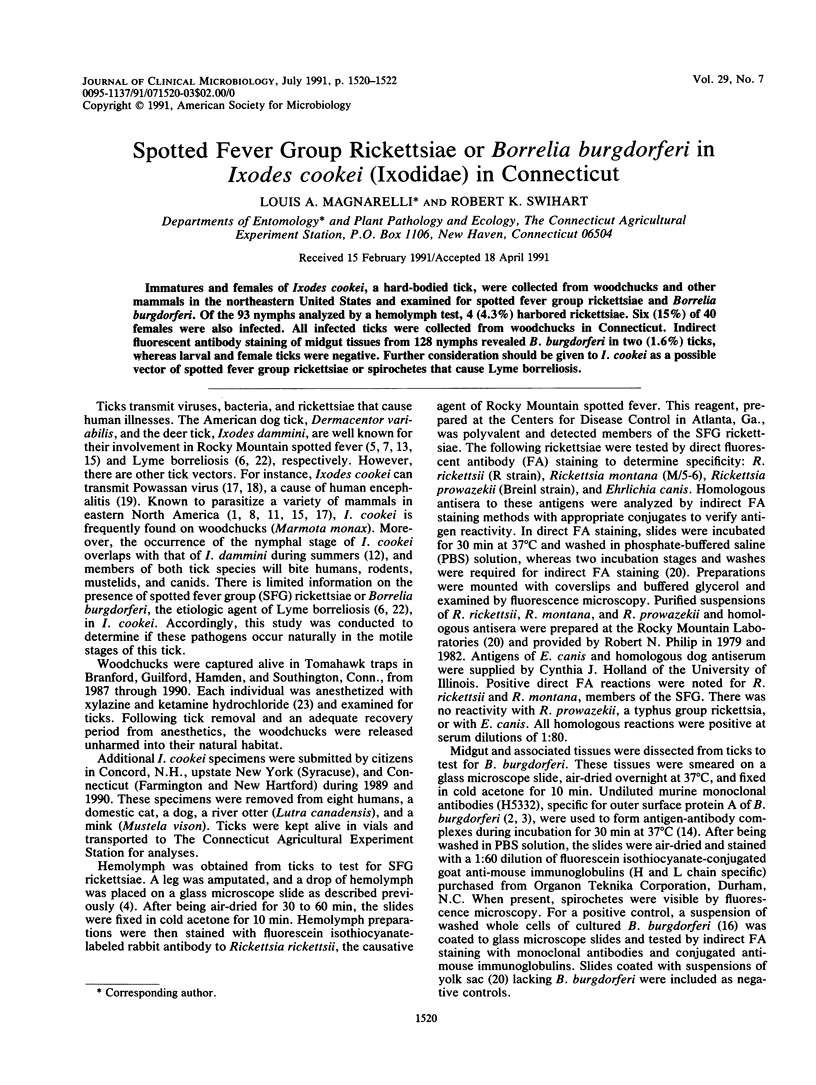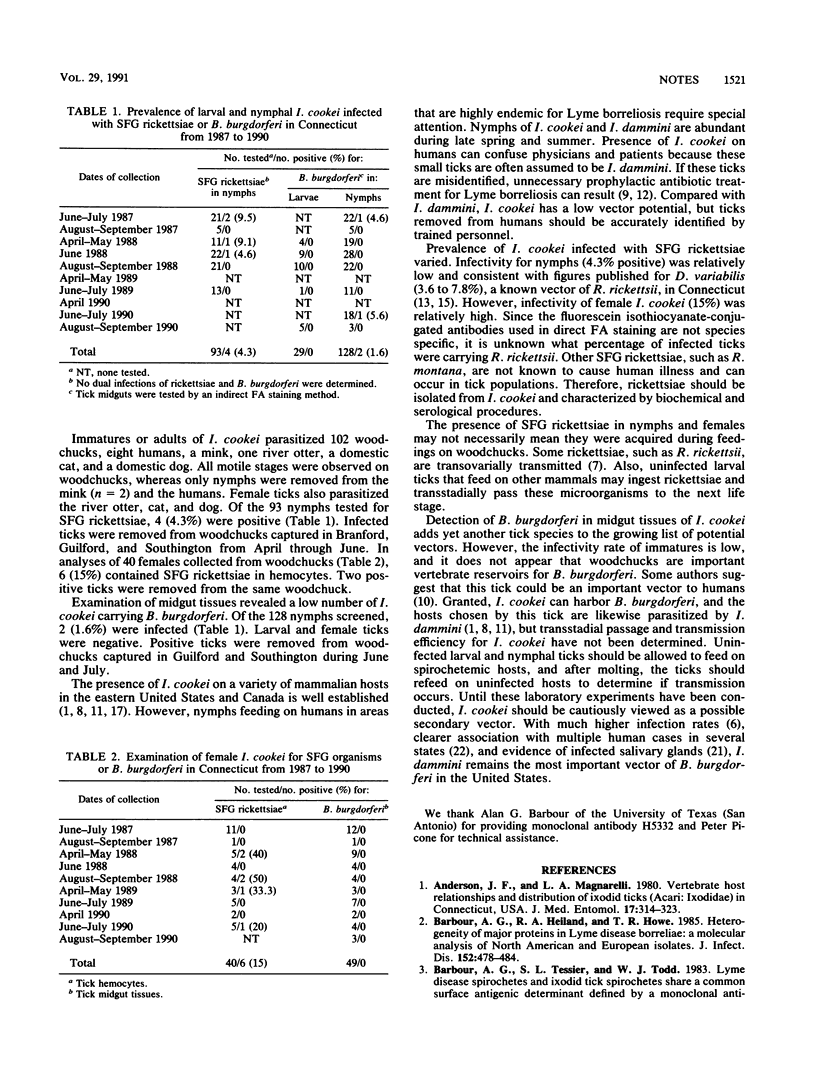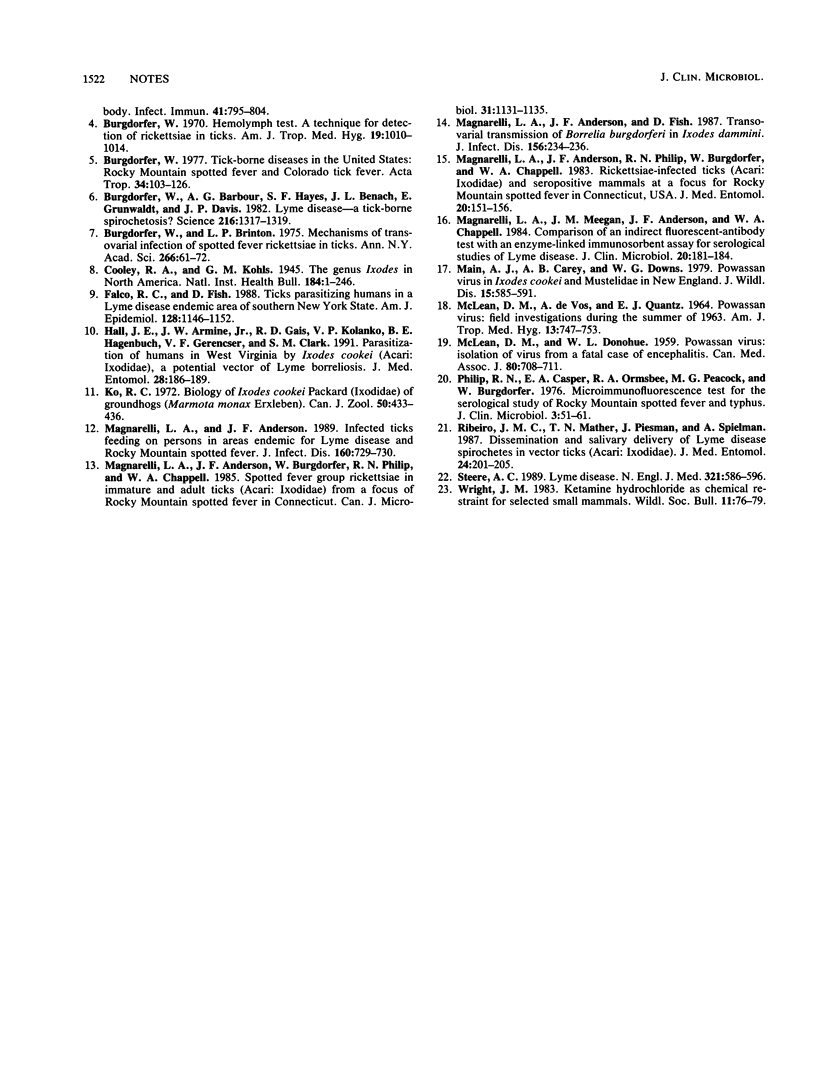Abstract
Immatures and females of Ixodes cookei, a hard-bodied tick, were collected from woodchucks and other mammals in the northeastern United States and examined for spotted fever group rickettsiae and Borrelia burgdorferi. Of the 93 nymphs analyzed by a hemolymph test, 4 (4.3%) harbored rickettsiae. Six (15%) of 40 females were also infected. All infected ticks were collected from woodchucks in Connecticut. Indirect fluorescent antibody staining of midgut tissues from 128 nymphs revealed B. burgdorferi in two (1.6%) ticks, whereas larval and female ticks were negative. Further consideration should be given to I. cookei as a possible vector of spotted fever group rickettsiae or spirochetes that cause Lyme borreliosis.
Full text
PDF


Selected References
These references are in PubMed. This may not be the complete list of references from this article.
- Anderson J. F., Magnarelli L. A. Vertebrate host relationships and distribution of ixodid ticks (Acari: Ixodidae) in Connecticut, USA. J Med Entomol. 1980 Jul 31;17(4):314–323. doi: 10.1093/jmedent/17.4.314. [DOI] [PubMed] [Google Scholar]
- Barbour A. G., Heiland R. A., Howe T. R. Heterogeneity of major proteins in Lyme disease borreliae: a molecular analysis of North American and European isolates. J Infect Dis. 1985 Sep;152(3):478–484. doi: 10.1093/infdis/152.3.478. [DOI] [PubMed] [Google Scholar]
- Burgdorfer W., Barbour A. G., Hayes S. F., Benach J. L., Grunwaldt E., Davis J. P. Lyme disease-a tick-borne spirochetosis? Science. 1982 Jun 18;216(4552):1317–1319. doi: 10.1126/science.7043737. [DOI] [PubMed] [Google Scholar]
- Burgdorfer W., Brinton L. P. Mechanisms of transovarial infection of spotted fever Rickettsiae in ticks. Ann N Y Acad Sci. 1975;266:61–72. doi: 10.1111/j.1749-6632.1975.tb35088.x. [DOI] [PubMed] [Google Scholar]
- Burgdorfer W. Hemolymph test. A technique for detection of rickettsiae in ticks. Am J Trop Med Hyg. 1970 Nov;19(6):1010–1014. [PubMed] [Google Scholar]
- Burgdorfer W. Tick-borne diseases in the United States: Rocky Mountain spotted fever and Colorado tick fever. A review. Acta Trop. 1977 Jun;34(2):103–126. [PubMed] [Google Scholar]
- Falco R. C., Fish D. Ticks parasitizing humans in a Lyme disease endemic area of southern New York State. Am J Epidemiol. 1988 Nov;128(5):1146–1152. doi: 10.1093/oxfordjournals.aje.a115057. [DOI] [PubMed] [Google Scholar]
- Hall J. E., Amrine J. W., Jr, Gais R. D., Kolanko V. P., Hagenbuch B. E., Gerencser V. F., Clark S. M. Parasitization of humans in West Virginia by Ixodes cookei (Acari: Ixodidae), a potential vector of Lyme borreliosis. J Med Entomol. 1991 Jan;28(1):186–189. doi: 10.1093/jmedent/28.1.186. [DOI] [PubMed] [Google Scholar]
- Ko R. C. Biology of Ixodes cookei Packard (Ixodidae) of groundhogs (Marmota monax Erxleben). Can J Zool. 1972 Apr;50(4):433–436. doi: 10.1139/z72-061. [DOI] [PubMed] [Google Scholar]
- MCLEAN D. M., DEVOS A., QUANTZ E. J. POWASSAN VIRUS: FIELD INVESTIGATIONS DURING THE SUMMER OF 1963. Am J Trop Med Hyg. 1964 Sep;13:747–753. doi: 10.4269/ajtmh.1964.13.747. [DOI] [PubMed] [Google Scholar]
- Magnarelli L. A., Anderson J. F., Burgdorfer W., Philip R. N., Chappell W. A. Spotted fever group rickettsiae in immature and adult ticks (Acari: Ixodidae) from a focus of Rocky Mountain spotted fever in Connecticut. Can J Microbiol. 1985 Dec;31(12):1131–1135. doi: 10.1139/m85-213. [DOI] [PubMed] [Google Scholar]
- Magnarelli L. A., Anderson J. F., Fish D. Transovarial transmission of Borrelia burgdorferi in Ixodes dammini (Acari:Ixodidae). J Infect Dis. 1987 Jul;156(1):234–236. doi: 10.1093/infdis/156.1.234. [DOI] [PubMed] [Google Scholar]
- Magnarelli L. A., Anderson J. F. Infected ticks feeding on persons in areas endemic for Lyme disease and Rocky Mountain spotted fever. J Infect Dis. 1989 Oct;160(4):729–730. doi: 10.1093/infdis/160.4.729. [DOI] [PubMed] [Google Scholar]
- Magnarelli L. A., Anderson J. F., Philip R. N., Burgdorfer W., Chappell W. A. Rickettsiae-infected ticks (acari: Ixodidae) and seropositive mammals at a focus for Rocky Mountain spotted fever in Connecticut, USA. J Med Entomol. 1983 Mar 30;20(2):151–156. doi: 10.1093/jmedent/20.2.151. [DOI] [PubMed] [Google Scholar]
- Magnarelli L. A., Meegan J. M., Anderson J. F., Chappell W. A. Comparison of an indirect fluorescent-antibody test with an enzyme-linked immunosorbent assay for serological studies of Lyme disease. J Clin Microbiol. 1984 Aug;20(2):181–184. doi: 10.1128/jcm.20.2.181-184.1984. [DOI] [PMC free article] [PubMed] [Google Scholar]
- Main A. J., Carey A. B., Downs W. G. Powassan virus in Ixodes cookei and Mustelidae in New England. J Wildl Dis. 1979 Oct;15(4):585–591. doi: 10.7589/0090-3558-15.4.585. [DOI] [PubMed] [Google Scholar]
- McLEAN D. M., DONOHUE W. L. Powassan virus: isolation of virus from a fatal case of encephalitis. Can Med Assoc J. 1959 May 1;80(9):708–711. [PMC free article] [PubMed] [Google Scholar]
- Philip R. N., Casper E. A., Ormsbee R. A., Peacock M. G., Burgdorfer W. Microimmunofluorescence test for the serological study of rocky mountain spotted fever and typhus. J Clin Microbiol. 1976 Jan;3(1):51–61. doi: 10.1128/jcm.3.1.51-61.1976. [DOI] [PMC free article] [PubMed] [Google Scholar]
- Ribeiro J. M., Mather T. N., Piesman J., Spielman A. Dissemination and salivary delivery of Lyme disease spirochetes in vector ticks (Acari: Ixodidae). J Med Entomol. 1987 Mar;24(2):201–205. doi: 10.1093/jmedent/24.2.201. [DOI] [PubMed] [Google Scholar]
- Steere A. C. Lyme disease. N Engl J Med. 1989 Aug 31;321(9):586–596. doi: 10.1056/NEJM198908313210906. [DOI] [PubMed] [Google Scholar]


